Latin name: Hylocereus
Category: dicots, epiphytic climbing cacti
Homeland: subtropical forests of Mexico, Antilles, South America
Hylocereus - the king of cacti
Hylocereus is the most charming of the cactus family. It grows well in the tropics and subtropics on many continents.
Hylocereus cactus is a large bush with widely overgrown branches, reaching a maximum height of two meters. The type of stems is wide and fleshy in diameter about 7 cm, and grow up to 3 meters in length, the stems are endowed with green waxy skin. Shoots spread over the surface horizontally and vertically.
The internodes contain filiform, aerial roots, their purpose is to receive nutrients coming to them from the air, and also serve as an attachment to the supports. The pointed ribs have soft spines for the most part, only some ribs are slightly sharp in length from 1 to 10 mm. There are species without spines.
Upon reaching two to four years, the Hylocereus cactus contains sufficient maturity and forms flowers. White, purple, milky-colored flowers up to 40 cm grow at the end of the stems and bloom at night. Closer to the morning, the buds close. Yellow stamens richly cover the core of the flower.
Pollination of cacti occurs with the help of nocturnal insects, due to which fragrant, edible fruits are formed - pitahaya. The size of the fruits is varied, they are like a small melon, and there are also like kiwi. The skin of the fruit is purple or pink on which small and soft growths grow.
The flesh of the fruits is pink or white with small black seeds, has a very tasty, juicy and delicious taste. When providing the plant with the necessary conditions for development, it blooms and bears fruit a maximum of five times during the year.
In total there are about 300 species of cacti. There are some that are considered edible. Cactus fruits contain a very unusual taste, which are widely used for cooking various dishes.
Edible cacti of such varieties: hylocereus, prickly pear, mammillaria.
Mammillaria cactus contains edible fruits that grow all year round. Sour berries are used raw for food and for jam.
Cactus fruit - prickly pear, is popular. Prickly pear is a sacred plant, most revered by the inhabitants of Mexico. Fresh fruits are endowed with tender, sweet and juicy pulp, they are used to make marmalade, jams, preserves.
Let's see how to eat prickly pear fruits. First of all, we clean the thorns in thick gloves. Then we process the fruit with a metal brush. Next, wash thoroughly under running water, washing off the thorns. After wearing thin gloves, make cuts on both sides of the fetus. Having done all these actions, prickly pear is allowed to be taken with hands without gloves. The fruits processed in this way can be consumed with the skin.
It is also possible to resort to another easier option. The fruit is cut into two halves and the pulp is selected with a spoon. Bones at a cactus can be chosen or left.
Cactus fruit is sweet, similar to the taste of persimmon. There are also varieties with sourness that have a coniferous flavor. As a result of the multifaceted taste, the fruits are used to prepare sweet and savory dishes.
Cacti hylocereus green lobbies, offices, living rooms. There is an opinion among people that cacti neutralize negative energy and create positive energy.
Hylocereus cactus, like other cacti, is endowed with the property of purifying the air, destroying harmful toxic substances.
Types of cactus hylocereus
Basically, cacti reproduce well and are grown indoors. The most common and captivating imagination will be considered further.
Hylocereus Costa Rican (Hylocereus costaricensis)
 The cactus grows with creeping and dense stems. At the end of the stems, large inflorescences are formed with white petals and purple edging. After pollination, the ovaries form ovoid purple fruits with tasty pulp.
The cactus grows with creeping and dense stems. At the end of the stems, large inflorescences are formed with white petals and purple edging. After pollination, the ovaries form ovoid purple fruits with tasty pulp.
Hylocereus narrow-winged (Hylocereus stenopterus)
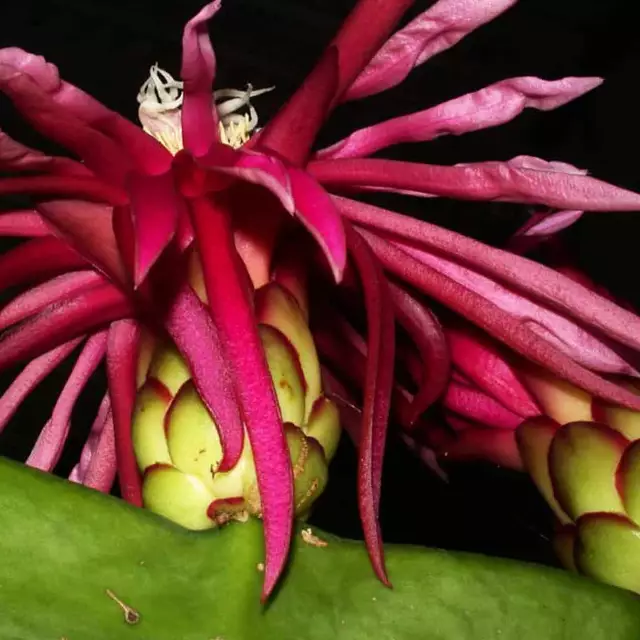 Compact cactus in height no more than 15 cm. Chestnut-colored stems contain pink tubular flowers when flowering. Pitahaya grow about 7 cm in diameter.
Compact cactus in height no more than 15 cm. Chestnut-colored stems contain pink tubular flowers when flowering. Pitahaya grow about 7 cm in diameter.
Wavy Hylocereus (Hylocereus undatus)
 The cactus has long wavy shoots with lateral edges that contain hard needles. The plant blooms with white flowers. The fruits grow red in diameter no more than 27 cm. Their flesh is white, fleshy and very juicy.
The cactus has long wavy shoots with lateral edges that contain hard needles. The plant blooms with white flowers. The fruits grow red in diameter no more than 27 cm. Their flesh is white, fleshy and very juicy.
Hylocereus trigonus
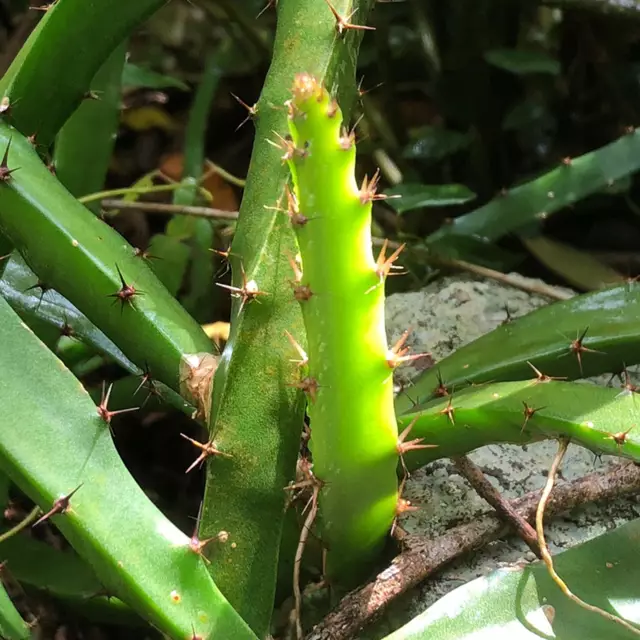 This type of cactus has creeping ribbed stems of a green hue. The edges have clusters of yellow needles. Plants are distinguished by large white inflorescences.
This type of cactus has creeping ribbed stems of a green hue. The edges have clusters of yellow needles. Plants are distinguished by large white inflorescences.
Hylocereus ocamponis
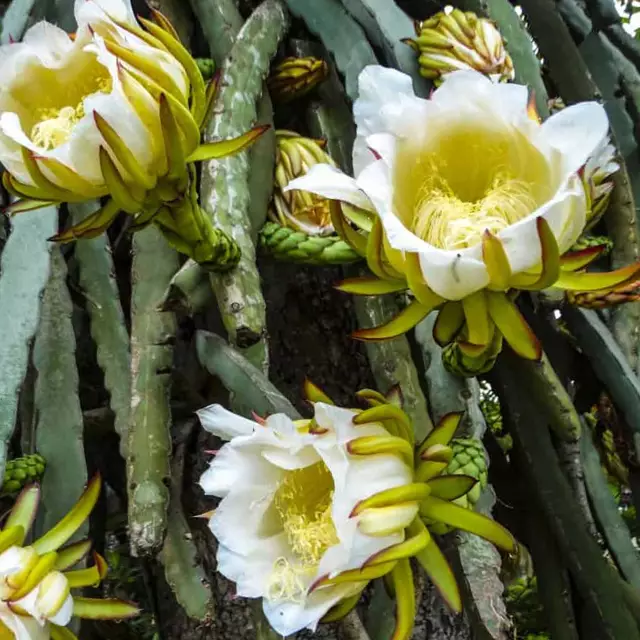 View from a creeper with similar green stems containing a blue tint along a length of about 3 meters. White inflorescences bloom at the ends of the shoots with f purple bracts. The plant has red or yellow pitahaya with a delicate smell.
View from a creeper with similar green stems containing a blue tint along a length of about 3 meters. White inflorescences bloom at the ends of the shoots with f purple bracts. The plant has red or yellow pitahaya with a delicate smell.
Hylocereus triangularis
 The stems of this species are pale green. The plant contains shoots with pointed edges, on which spines are occasionally located. At the ends of the shoots, white buds are formed in diameter - 20 cm. Perennial cacti contain red berries, their diameter is no more than 5 cm.
The stems of this species are pale green. The plant contains shoots with pointed edges, on which spines are occasionally located. At the ends of the shoots, white buds are formed in diameter - 20 cm. Perennial cacti contain red berries, their diameter is no more than 5 cm.
Hylocereus field
Cactus with crooked gray stems about two meters. On the pointed edges of the plant are yellow needles collected in bunches. Cactus flowers are white, have light green stains, their length is not more than 30 cm. Pink fruits contain yellow or orange juicy and tasty pulp, the taste resembles ripe melons.
Hylocereus home care
Cactus adapt to the conditions of apartments at ease and does not require special care. Growing a cactus is not difficult, as it is unpretentious, and a beginner grower can grow it. The main thing that needs to be done for good development and flowering is proper lighting support.
Site selection and lighting
The location of cacti is suitable on any windowsill with good lighting. The cactus tolerates direct sunlight perfectly, no need to shade on the saucer on the south side.
Temperature
The optimum temperature for cacti is from 22 to 28℃ throughout the warm season. In winter, the plant needs a cool temperature of 16 to 19℃, at which time a dormant period begins. Maintaining this temperature contributes to a beautiful decorative look.
Watering
The cactus is recommended to be watered often, but moderately and systematically. Requires softened, filtered or rain water for irrigation. If you overmoisten the soil from time to time, there will be no negative consequences, however, with regular waterlogging of the soil, it will lead to the development of root rot. With short-term drying of the soil, negative consequences will not occur.
Humidity
If the indoor air is dry, the cactus develops normally. It is optimal to maintain air humidity from 55 to 60%.
The soil
Cactus requires slightly acidic, breathable and permeable soil. It is recommended to use turf, peat, sand in the same parts for the preparation of the substrate. Perlite is added to loosen the soil. fertilizers
It is necessary to apply specialized fertilizers to cacti during the growing season from 2 to 4 times. It is allowed to use organic fertilizers weakly concentrated.
Transfer
The cactus has a sensitive root system, so we transplant only when needed and in the spring.
You should inspect the plant and determine the state of the root system, whether there is enough space for it or not enough. Sometimes it is possible to change only the layer of soil located on top. Having made a transplant, you can not fertilize and reduce watering, maintain the required temperature.
Reproduction
Hylocereus cacti are propagated by seeds and cuttings.
When propagating by seeds, leafy soil and sand should be mixed. The mixture must be damp for sowing seeds. Using a spray gun, spraying is done, thereby replacing watering. Next, the soil is covered with a film and the temperature is maintained at about 20 ℃ until the seeds germinate. Germination time lasts at least three weeks.
Under the right conditions, early flowering will appear after two or three years of growth.
When propagating by cuttings, you need to divide the stem into parts. Then they should be dried for two days in a darkened and ventilated room. Next, root the cuttings in a mixture of leafy soil and sand. It is recommended to water in the pan and spray systematically. Rooting time for cuttings is a month. Rooted cuttings must be accustomed to lighting slowly.
Pests and diseases of the cactus hylocereus
Failure to follow the recommended rules for caring for a cactus will certainly lead to difficult situations. If measures are not taken immediately to eliminate the mistakes made, which led to diseases and pest damage, the cactus will die. These are the signs of diseases of the cactus hylocereus:
- The appearance of an unpleasant odor spreading from the soil - infection with rot. Rot disease occurs due to improper watering.
- Soft shoots, slow growth of shoots, no flowering for a long time - lack of lighting and minerals.
Pests of cacti consist of mealybugs, spider mites. The defeat of these pests occurs during drought and heat. Insecticides are used to control pests.
Prevention is considered to be maintenance of air humidity at a high level and overheating of the plant should be counteracted.
Difficult moments when growing a cactus hylocereus
- No flowering - not enough green mass or lack of lighting.
- Deteriorating appearance - high temperature above 25℃ or very low temperature less than 0℃.
The cactus hylocereus is unpretentious, it can give the interior a charmingly beautiful look, it will give a beautiful view to the garden, cottage, balcony. Cactus care does not require much attention, only adhering to competent care is possible. you can grow a spectacular, ornamental plant.




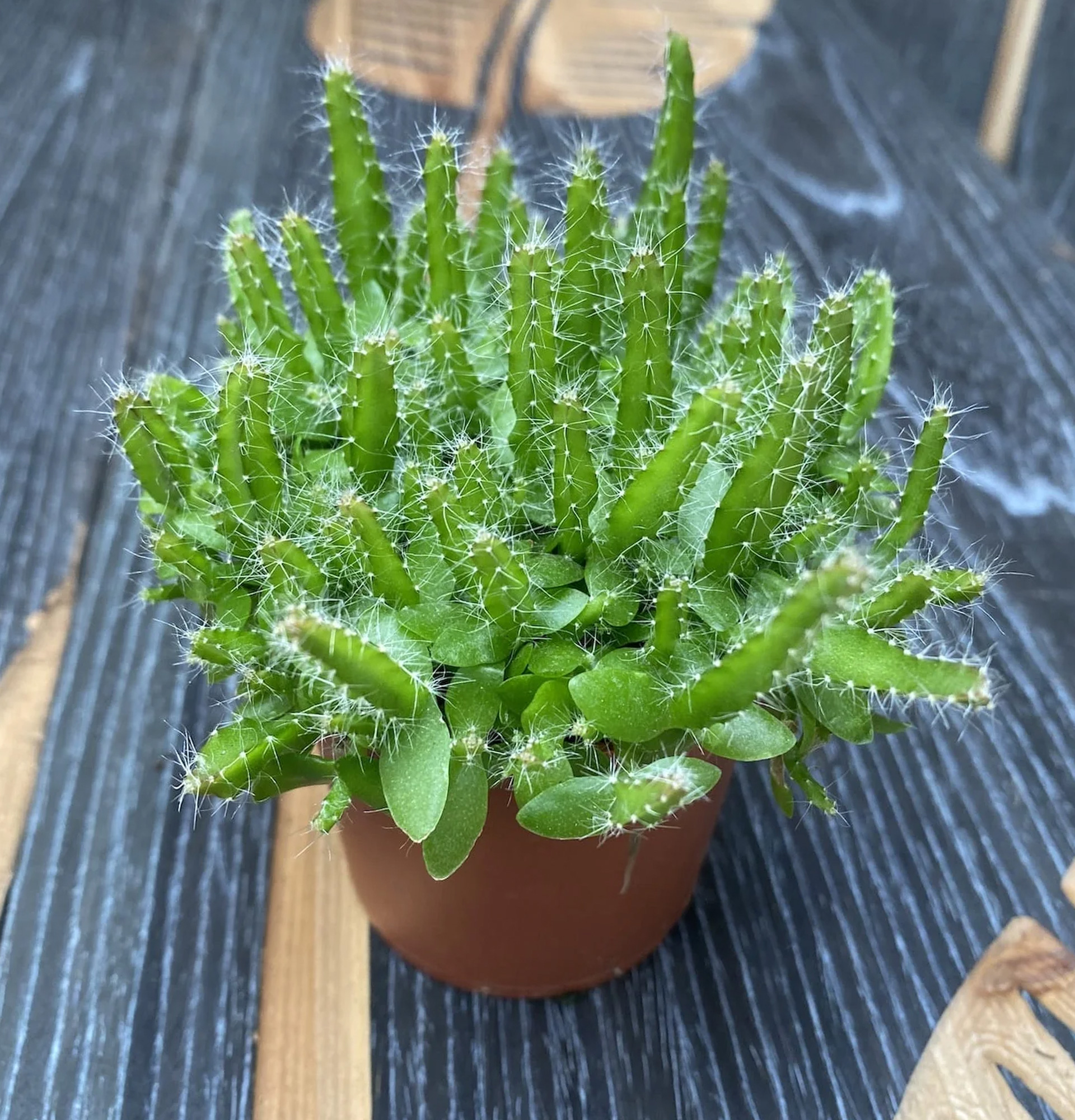










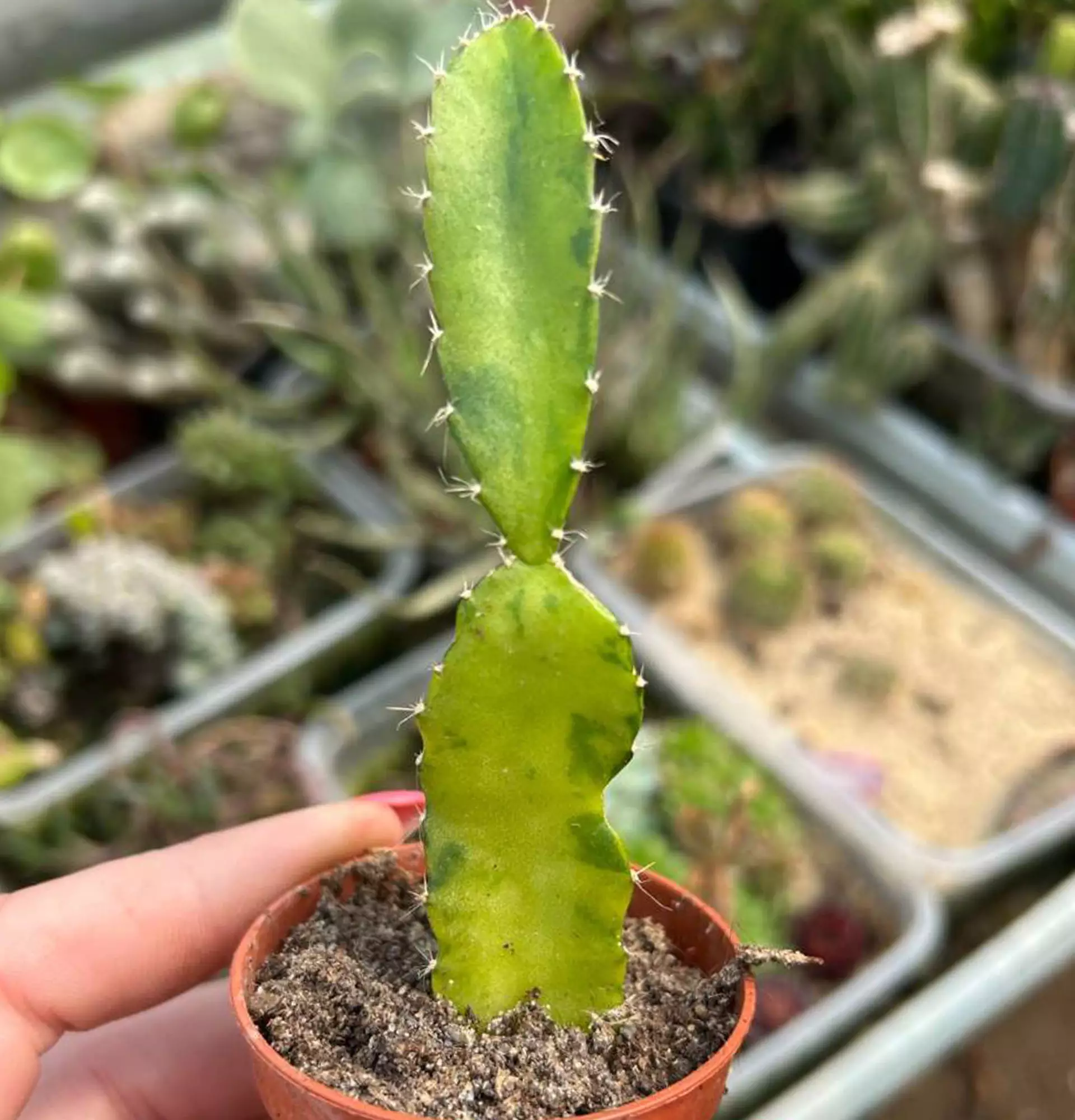

Write comments
Comments